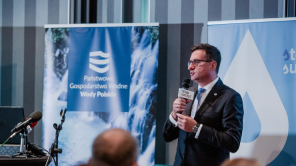We want to spend PLN 400 million this year on anti-drought activities. Funds for counteracting the effects of drought will increase every year – Przemysław Daca, the president of Polish Waters, announced in an interview with PAP (The Polish Press Agency).
At the end of February, Polish Waters reported that despite the rainfall that occurred at that time, drought was still threatening Poland. High temperature, which caused faster evaporation of moisture from soil, was the problem. The National Water Management Authority indicated that in the case of persistent unfavourable meteorological conditions (no rain, high temperature), the so-called low-water period may occur in large areas of Poland, i.e. a decrease in groundwater level, which – in the case of shallow water intakes – may cause water shortage.
“We do not try to scare anybody. We want to make our society aware of the hydrological situation in Poland. Our country is poor in water and this is an undeniable fact. This problem has been particularly evident in recent years. Analyses and scientific research indicate that in order to counteract the effects of drought, coordinated actions of many institutions are needed, e.g. Polish Waters, local governments, ministries, but also the whole society, individual citizens,” emphasized the president of Polish Waters.
Daca noted that the hydrological situation in the country is not uniform, generally it is better in the south. “The worst situation is in central Poland, in the Łódź Voivodeship, the Kuyavian-Pomeranian Voivodeship and in parts of the Greater Poland and Lublin Voivodeships. The problem there is very serious. Our forecasts are also confirmed by the research of the Institute of Soil Science and Plant Cultivation in Puławy, which indicates that we have had a practically permanent state of agricultural drought for four years,” he added.
On the fifteenth of February, the public consultation on the Drought Effects Counteracting Plan (DECP) ended. The document, together with plans for water management and flood risk management, is to contribute to the improvement of the state of water management in Poland. DECP will also undergo a strategic environmental impact assessment. It is to be implemented later this year by the ordinance of the minister of maritime economy and inland navigation.
“DECP will define, among others what is drought, when we can talk about it, what are its types. The document will also contain a catalogue of necessary tasks, the implementation of which will improve the situation in Poland. We can already see that the programme must be combined with another strategy for increasing water retention in the country, which provides for a very important investment component reaching over PLN 10 billion,” explained the president.
The Head of Polish Waters said that this year around PLN 400 million will be allocated to fight drought. In the following years these funds will increase – he assured.
He explained that one of the projects financed from these funds will be investing in small retention, as well as in drainage and irrigation, and even more in reversing the current trend.
“We suffer a little as a result of EU subsidies for crops. Farmers increased their agricultural acreage at all costs, mid-field trees, small swamps – i.e. places that positively affect soil water retention were eliminated. Added to this is the terrible condition of the drainage and irrigation infrastructure, canals and weirs. This trend should be reversed,” said Daca.
The first investments will be conducted in the West Pomeranian Voivodeship, where for PLN 40 million nearly 150 water devices are to be renovated to improve water retention in agricultural areas.
The President of Polish Waters announced that this programme will be extended to other voivodeships. The company’s analysis shows that the reconstruction of the so-called basic drainage and irrigation infrastructure in Poland is to cost about PLN 500 million. Due to the fact that drainage and irrigation concerns agriculture, Polish Waters want to obtain funds, e.g. from the RDP (Rural Development Programme). Negotiations with the Minister of Agriculture, Jan Krzysztof Ardanowski, are ongoing.
Daca also announced that programmes would be developed to encourage rainwater capture and its subsequent use, e.g. for watering. In the near future – he added – a special programme aimed at local governments is to be presented. It will assume the construction of drainage, wells on sealed surfaces (e.g. parking lots) and subsequent drainage of water into the soil.
“We want to coordinate rainwater capture programmes nationwide. We also want to sign agreements with local governments and help them raise funds, e.g. from the National Fund for Environmental Protection and Water Management,” added the head of Polish Waters.
In Poland, there is an average of 1.6 to 1.8 thousand cubic meters of water per capita per year. In recent years, due to the drought, this ratio has fallen even to 1.1 thousand cubic meters
We collect and hold for a long time approximately 4 billion cubic meters of water in the country, which is about 6.5 percent of the volume of the average annual river outflow. The total river outflow consists of water supplied to the riverbed, e.g. as a result of rainfall or melting snow. According to the plan to increase retention, this ratio is to be twice as high and amount to about 15 percent.
Source: PAP



Awsome article and right to the point. I am not sure if this is really the best place to ask
but do you people have any ideea where to get some professional writers?
Thanks 🙂 Najlepsze escape roomy
You have mentioned very interesting details! ps decent internet site.?
Spot on with this write-up, I truly think this website needs much more attention. I’ll probably be returning to read more, thanks for the info!
I really love your blog.. Pleasant colors & theme. Did you make this site yourself? Please reply back as I’m attempting to create my own personal blog and would love to learn where you got this from or exactly what the theme is named. Thank you!
Good article. I will be facing many of these issues as well..
Hi there, I do think your website could be having web browser compatibility problems. When I look at your web site in Safari, it looks fine but when opening in IE, it’s got some overlapping issues. I merely wanted to provide you with a quick heads up! Besides that, excellent website.